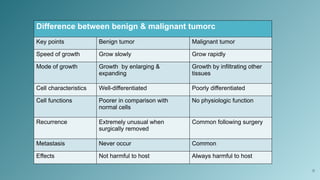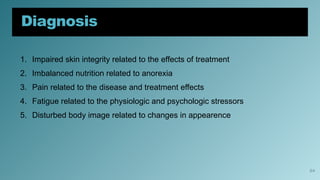CANCER (nursing management of cancer patient).pptx
- 1. “EARLY DETECTION, SAVE LIVES” Satu Chakroborti RN, BSN Nursing Instructor, RNI
- 2. 2 INTRODUCTION “Oncological Nursing” is the study and treatment of tumors, may be benign or malignant. The term “Onco” means mass, relating to tumors. Oncogenes, a gene which in certain circumstances can transform a cell into a tumor cell. The term cancer is an “umbrella” word used to describe more than 270 diseases in which cells multiply without restraint, destroying healthy cells, and endangering life. Oncological nurses must have a broad knowledge of both pathophysiology and psychosocial arena. They must be prepared to support patients and families through a wide range of physical, emotional, social, and spiritual crises.
- 3. 3 Cancer The word cancer often abbreviated as Ca, is a term that frightens most people. Cancer is a disease of the cell in which the normal mechanism of control of growth and proliferation is disturbed. Cancer is a collective term describing a large group of diseases characterized by uncontrolled o growth and spread of abnormal cells. This group of diseases: Arises from any tissue or organ Differ greatly from one another in appearance and growth. May follow very different courses of development in their host. Respond differently to the variety of therapies applied to them.
- 4. 4 Important terms used in cancer Abnormal new growth or formation of tissue that serves no useful purpose and may harm the host organism. Tumor cells that are completely undifferentiated and bear no resemblance to cells of tissues of their origin. Increase in the number of normal cells in a normal arrangement in a tissue or organ Replacement of one type of fully differentiated cell by another type fully differentiated An alteration in the size, shape and organization of the cells usually in response to an irritant may transform to neoplasia. The ability of neoplastic cells to spread from the original site of the tumor to distant organs. A form of cancer that is composed of epithelial cells that tend to infiltrate surrounding tissues and may eventually spread to distant sites. Neoplasm Anaplastic Hyperplasia Metaplasia Dysplasia Metastasis Carcinoma
- 5. 5 Characteristics of normal and malignant cells Traits Normal cells Malignant cells Mitotic cell division Two daughter cells Multiple cells Appearance Homogenous in size and shape Pleomorphic and heterogenous Invasion Do not invade adjacent tissue Invade adjacent tissue Function Have specific and designed purpose Serve no useful purpose Growth rate Constant and predictable cell growth rate Erratic cell growth rate Number of chromosomes Remain constant throughout cell division Chromosomal aberrations occur as the cell matures Growth inhibition Exhibit contact inhibition Do not exhibit contact inhibition
- 6. 6 Etiology of cancer Physical carcinogens: cause cellular damage such as ultraviolet and ionizing radiation, foreign bodies Chemical carcinogens: such as asbestos, components of tobacco smoke, alcohol, aflatoxin (a food contaminant), and arsenic (a drinking water contaminant), nickel, uranium, cadmium, nitrates etc. Biological carcinogens: such as infections from certain viruses, bacteria, or parasites. HIV, HBV, HPV, Epstein-Barr virus etc, Drugs and Hormones: such as Alkylating agents, Antimetabolites, corticosteroids, Synthetic estrogen-prenatal, Amphetamine
- 7. 7 Classification of cancer Anatomic site classification: According to the origin, anatomic site, and behavior of the tumor: 1. Benign 2. Malignant Carcinoma: originates from embryonical ectoderm(skin and glands), and endoderm(mucous membrane lining of the respiratory tract, GI tract & genitourinary tract). Sarcoma: originates from embryonical mesoderm (connective tissue, muscle, bone, and fat) Lymphoma & leukemia: originates from the hematopoietic system
- 8. 8 Difference between benign & malignant tumorc Key points Benign tumor Malignant tumor Speed of growth Grow slowly Grow rapidly Mode of growth Growth by enlarging & expanding Growth by infiltrating other tissues Cell characteristics Well-differentiated Poorly differentiated Cell functions Poorer in comparison with normal cells No physiologic function Recurrence Extremely unusual when surgically removed Common following surgery Metastasis Never occur Common Effects Not harmful to host Always harmful to host
- 9. 9
- 10. 10 Histologic analytic classification: Grade I: Cells differ slightly from normal cells (mild dysplasia) and are well differentiated. Grade II: Cells are more abnormal (moderate dysplasia) and moderately differentiated. Grade III: Cells are very abnormal (severe dysplasia) and poorly differentiated. Grade IV: Cells are immature and primitive (anaplasia) and undifferentiated, and the cell of origin is difficult to determine.
- 11. 11 In the TNM system The T refers to the size and extent of the main tumor. The main tumor is usually called the primary tumor The N refers to the number of nearby lymph nodes that have cancer. The M refers to whether the cancer has metastasized This means that the cancer has spread from the primary tumor to other parts of the body. When your cancer is described by the TNM system, there will be numbers after each letter that give more details about the cancer—for example, T1N0MX or T3N1M0. The following explains what the letters and numbers mean. Primary tumor (T) TX: Main tumor cannot be measured. T0: Main tumor cannot be found.
- 12. 12 T1, T2, T3, T4: Refers to the size and/or extent of the main tumor. The higher the number after the T, the larger the tumor or the more it has grown into nearby tissues. T's may be further divided to provide more detail, such as T3a and T3b. Regional lymph nodes (N) NX: Cancer in nearby lymph nodes cannot be measured. N0: There is no cancer in nearby lymph nodes. N1, N2, N3: Refers to the number and location of lymph nodes that contain cancer. The higher the number after the N, the more lymph nodes that contain cancer. Distant metastasis (M) MX: Metastasis cannot be measured. M0: Cancer has not spread to other parts of the body. M1: Cancer has spread to other parts of the body.
- 13. 13 Warning signs of Cancer Must know the seven warning signs of Cancer, which include “CAUTION’ as follows: 1. Change in bowel or bladder habits 2. A sore that does not heal 3. Unusual bleeding or discharge 4. Thickening or lump in the breast or elsewhere 5. Indigestion or difficulty in swallowing 6. Obvious changes in a wart or mole 7. Nagging cough or hoarseness.
- 14. 14 Clinical manifestations Generally manifestations are related to the system affected and degree of disruption. Common features are: Cancerous cells spread from one organ or body part to another by invasion or manifestation. Cancer causes anemia, weakness, weight loss(dysphagia, anorexia, blockage) and pain (often in late stages). Depressed immune system Changes in bowel or bladder(diarrhea, constipation, frequent urination or pain) Unusual bleeding or discharge( discharge from nipple, blood in stool, urine and vomit)
- 15. 15 Risk factors of Cancer Age Sex Occupatio n Heredity Diet and nutrition Stress Precancer ous lesions
- 16. 16 Prevention of cancer Some cancers can be prevented by avoiding recognized carcinogens and altering health behaviors. Primary prevention: Reduce carcinogens Eat a balanced diet Actively exercise Consistent rest(6-8 hours at night) Health check-ups(regular) Eliminate/reduce stress Relax and enjoy leisure
- 17. 17 Secondary prevention: Searching for early signs: This is the core of secondary prevention. actively looking for cancer in its early, more treatable stages by doing regular check-ups. Checking specific sites: Screening for particular cancers like lung(Paying attention to changes in cough, sputum, breathing, chest X-rays for high-risk individuals), colon(digital rectal exams, regular stool checks), Cervix & Endometrium(yearly pap test & pelvic examination, abnormal bleeding or change in the menstrual pattern), Breast(monthly self-exams, mammogram after 50, being aware of lump, nipple discharge or pain) Regularly Testing Examining for changes: Professional examination and self-awareness Early diagnosis: Catch cancer early to have better treatment outcomes Noting risk factors: Understanding who is at higher risk for certain cancers(e.g. smokers, family history of breast & colon cancers) helps target screening efforts effectively.
- 18. 18 Treatment The goal of cure, control and palliation are achieved through the use of four treatment modalities for cancers which includes: 1. Surgery 2. Radiotherapy 3. Chemotherapy 4. BRM(Biologic response modifiers)
- 19. 19 Surgery It is the ideal and most frequently used treatment method. The surgical management of cancer are as follows: 1. Biopsy 2. Reconstructive surgery 3. Palliative surgery 4. Adjuvant surgery 5. Preventive/prophylactic surgery 6. Curative surgery 7. Debulking surgery
- 20. 20 Radiotherapy It is the use of high energy ionizing rays to treat a variety of cancer. Types: External RT: used outside the body. Administered by high-energy X-ray machine, cobalt 60. Internal RT: Involves the placement of specially prepared radioisotopes, which directly enter near the tumor itself. Two types of internal RT, Sealed source(cesium 137, radium 226 , iodine 125 etc) Unsealed source( Phosphate P32 intravenously, Iodine 131 orally)
- 21. 21 Chemotherapy Chemotherapy is the systemic treatment of cancer with chemicals i.e. drugs. The common drugs used as chemotherapeutic agent are as follows: 1. Alkylating agents: mechlorethamine, Cytoxan, leukeran, myleran. 2. Antimetabolites: methotrexate, 6MP, 6TG, 5Fu 3. Antitumor antibiotics: Adriamycin, mutamycin, Idamycin 4. Hormonal agents: Halostin, Dexamethasone, Estriny, Provera 5. Epipodophyllotoxins 6. Vinca alkaloids: Oncovin, velban
- 22. 22 Side effects of chemotherapy GI system: Dry mucous membrane, stomatitis, esophagitis, nausea & vomiting, anorexia, diarrhea. Hematopoietic system: anemia, leukopenia, thrombocytopenia Integumentary system: Alopecia, skin reaction Genitourinary tract: cystitis, reproductive dysfunction, nephrotoxicity Nervous system: increased ICP, peripheral neuropathy Respiratory system: pneumonitis Cardiovascular system: pericarditis, myocarditis, cardiotoxicity Psycho-emotional fatigue
- 23. 23 Nursing management Assessment: Assess the patient for secondary problems such as infection, reduced WBC count, bleeding, psychological stress, skin problems, nutritional problems, pain, and fatigue. Monitor laboratory studies Monitor patient for sepsis Monitor common bleeding sites Review the patient’s medication history
- 24. 24 Diagnosis 1. Impaired skin integrity related to the effects of treatment 2. Imbalanced nutrition related to anorexia 3. Pain related to the disease and treatment effects 4. Fatigue related to the physiologic and psychologic stressors 5. Disturbed body image related to changes in appearence
- 25. 25 Planning 1. Maintain adequate skin integrity 2. Maintains adequate nutritional status 3. Reduction of pain to a tolerable and manageable level 4. Demonstrates increased activity tolerance and decreased fatigue 5. Exhibits improved body image and self-esteem
- 26. 26 Intervention Assess the pain to provide a baseline treatment Use an analgesic ladder (1. non-opioid, 2. weak opioid, 3. strong opioid) Assess oral mucosa daily and observe for dryness, redness, and the presence of any breaks in the tissue Teach the patient to use a soft-bristled toothbrush, encourage the drinking of water, and apply a small amount of petroleum jelly Provide a well-balanced diet with small frequent feedings every few hours Administer antiemetic medication as prescribed and ensure adequate hydration
- 27. 27 cont. Inform the patient that fatigue is an expected side effect of therapy and encourage the patient to rest when fatigued. Provide psychologic support and prepare the patient for expected hair loss Avoid excessive shampooing and encourage the patient to select a wig
- 28. 28 Reference BT Basavanthappa – Medical & Surgical Nursing, 3rd edition, Vol- 1 American Cancer Society



























